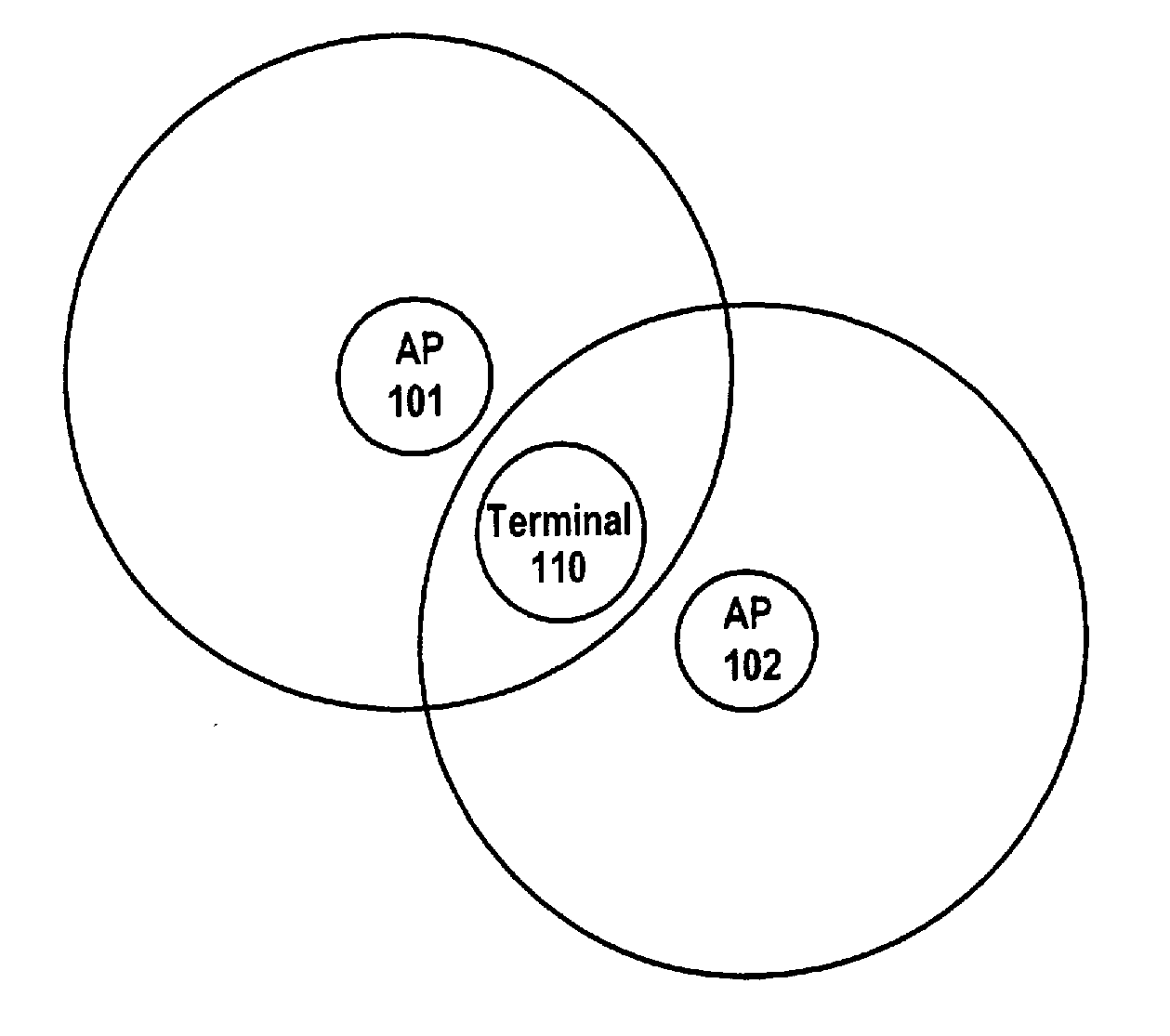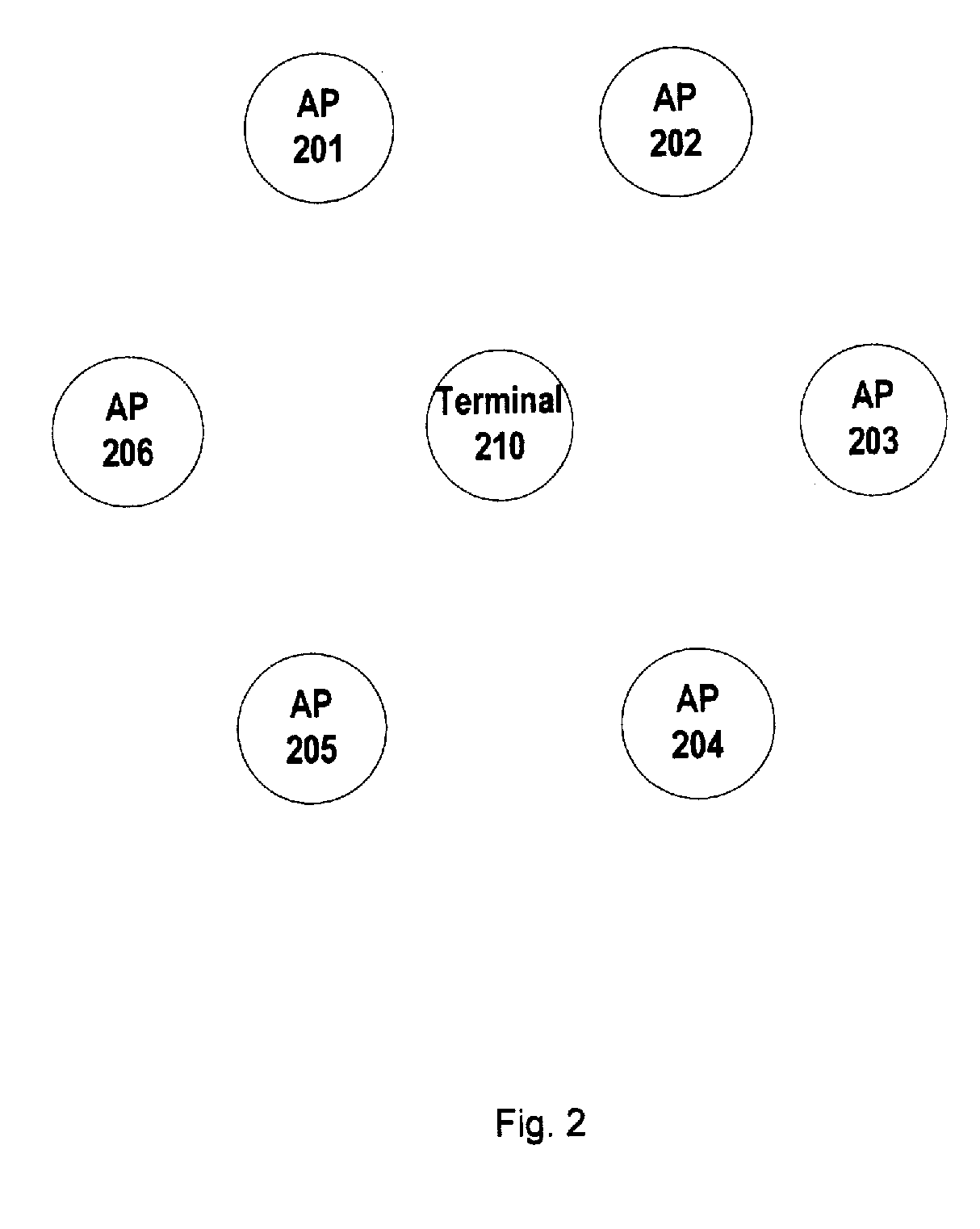Method, Access Point and Terminal for Selecting Channel in Wireless Local Area Networks
a wireless local area network and access point technology, applied in the field of wireless local area networks, can solve the problems of channel having a negative impact on the service quality experienced by the terminal, channel based on the 802.11a standard is rarely seen in the market, and the available bandwidth of each client is thus limited, so as to improve the available bandwidth of the terminal, avoid conflicts, and improve the experience of users
- Summary
- Abstract
- Description
- Claims
- Application Information
AI Technical Summary
Benefits of technology
Problems solved by technology
Method used
Image
Examples
exemplary embodiment 1
[0027]A method for selecting a channel for an AP according to the present invention shown in FIG. 4 will be described with reference to the schematic diagram illustrating a distribution of a terminal and APs in a WLAN shown in FIG. 1. The network environment shown in FIG. 1 is similar to those described above, and thus its description is omitted herein.
[0028]In step S401, a terminal collects network conditions of APs within its sensing range.
[0029]In the related art, each AP may broadcast its current network conditions on the used channel periodically, and this has been described in ANSI / IEEE Std 802.11, 1999 Edition, Telecommunications and information exchange between system, Local and metropolitan area networks Specific requirements, Part 11: Wireless LAN Medium Access Control (MAC) and Physical Layer (PHY) Specifications, 1999 (Document 1) which is incorporated by reference herein in its entirety. Thus, terminals can collect the network conditions broadcasted by these APs accordi...
exemplary embodiment 2
[0045]A brief description of the method, as shown in FIG. 4, for selecting a channel for an AP according to the present invention will be given with reference to FIG. 2. Lines representing AP's coverage range are omitted in FIG. 2 for clarity.
[0046]In the WLAN shown in FIG. 2, APs 201-206 are within the sensing range of terminal 210, but none of the APs are within sensing ranges of each other. It is assumed that AP 201, AP 202 and AP 203 operate on channel 1, AP 204 on channel 6, and APS 205 and 206 on channel 11.
[0047]In accordance with the method shown in FIG. 4, the terminal 210 collects network conditions of APs 201-206 in step S401, and sends the collected network conditions to APs 201-206 in step S402.
[0048]Taking AP 201 as an example, AP 201 learns that: it is operating on channel 1 with two other APs at the same time, there are two APs operating on channel 11, and only one AP is operating on channel 6. Thus AP 201 selects the channel where there are the fewest APs operating ...
exemplary embodiment 3
[0049]A method for selecting a channel for an AP according to the present invention will be described as shown in FIG. 3.
[0050]In the WLAN shown in FIG. 3, AP 301 provides services to terminals 310-312; APs 302 and 303 are within the sensing range of terminal 310; AP 304 is within the sensing range of terminal 311; and APs 305 and 306 are within the sensing range of terminal 312.
[0051]In step S401, AP 301 attempts to select a channel. Terminals 310-312 collect network conditions of APs within their own sensing ranges, that is, all terminals accepting service from AP 301 collect network conditions of APs within their own respective sensing ranges.
[0052]Alternatively, network conditions can be collected by less than all of terminals 310-312. In step S402, terminals 310-312 send the collected network conditions to all APs within their own respective sensing ranges.
[0053]Additionally, if terminals 310-312 are unable to send network conditions of other APs to AP 301 simultaneously, AP 30...
PUM
 Login to View More
Login to View More Abstract
Description
Claims
Application Information
 Login to View More
Login to View More - R&D
- Intellectual Property
- Life Sciences
- Materials
- Tech Scout
- Unparalleled Data Quality
- Higher Quality Content
- 60% Fewer Hallucinations
Browse by: Latest US Patents, China's latest patents, Technical Efficacy Thesaurus, Application Domain, Technology Topic, Popular Technical Reports.
© 2025 PatSnap. All rights reserved.Legal|Privacy policy|Modern Slavery Act Transparency Statement|Sitemap|About US| Contact US: help@patsnap.com



